Abstract
Fibroblasts from the brindled mouse model of Menkes disease are known to accumulate excess copper. Most of the copper in the cytosol of these fibroblasts is bound to metallothionein (MT), which is elevated in Menkes or brindled mouse fibroblasts. Copper accumulation by normal fibroblasts containing excess MT was examined to determine if the excess copper accumulation phenotype was secondary to excess MT or associated with the primary defect in fibroblasts from the brindled mice. MT was induced in normal fibroblasts by copper, zinc or dexamethasone to levels comparable with those in brindled mice fibroblasts, as determined by radioimmunoassays. Normal fibroblasts containing excess MT accumulate copper normally, i.e. they do not exhibit the excess copper accumulation phenotype. Consistent with this result, copper efflux from normal fibroblasts containing excess MT was also normal. The data suggest that one function of the protein associated with the primary defect is to help determine how much copper is taken up and retained by fibroblasts and other cell types exhibiting the excess copper phenotype in Menkes disease. The capacity of this protein is apparently exceeded in normal fibroblasts if serum or albumin is not present extracellularly to limit total copper uptake. Consistent with a defect in an intracellular protein, the kinetics of copper transport by brindled mice fibroblasts were found to be normal.
Full text
PDF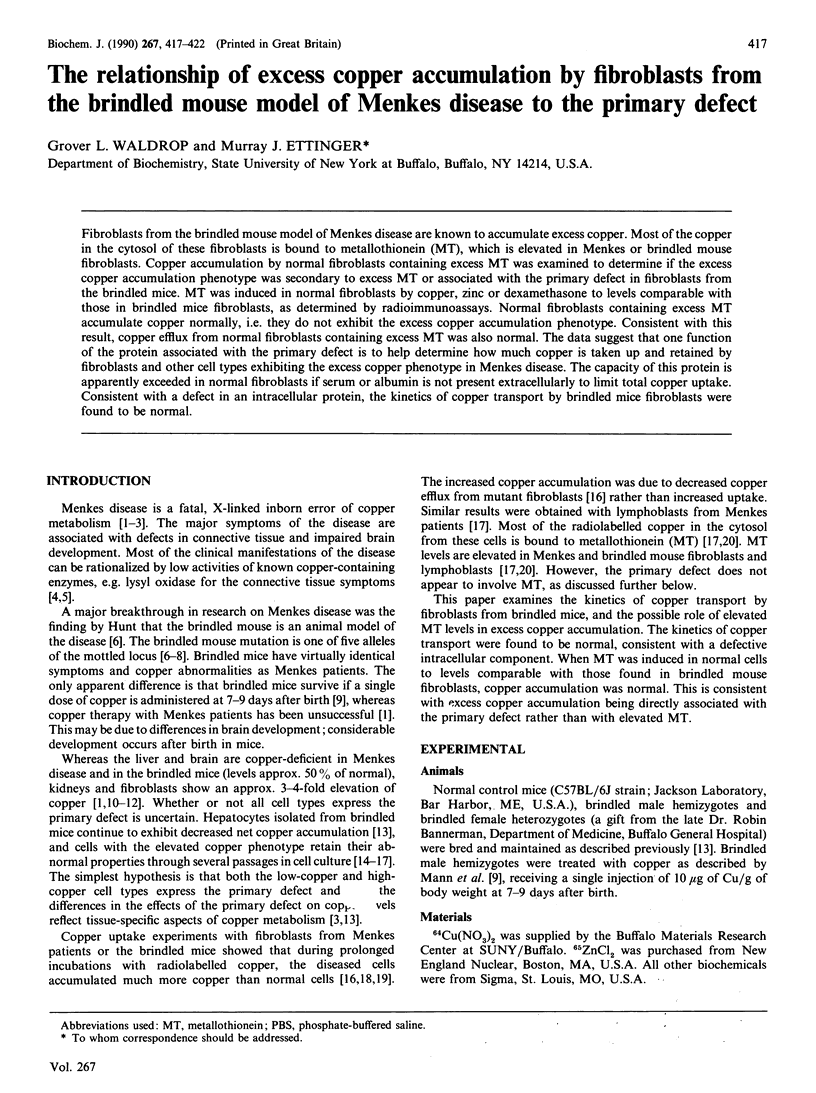
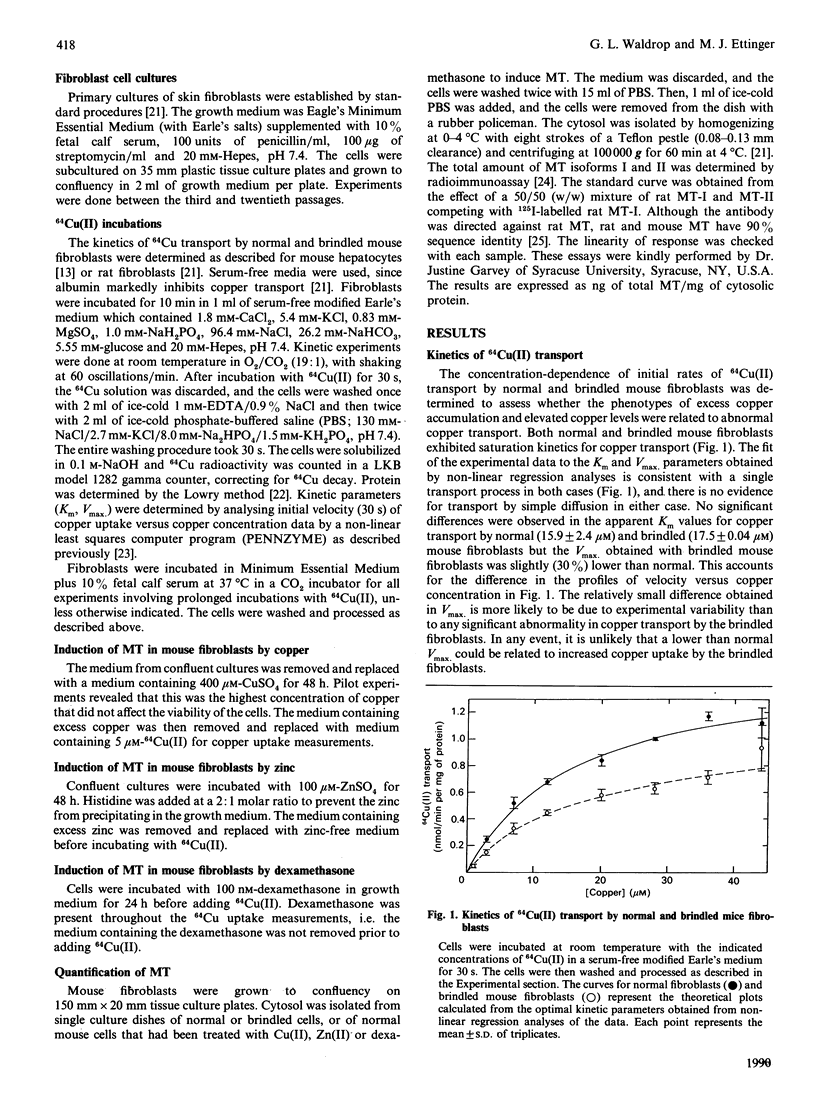
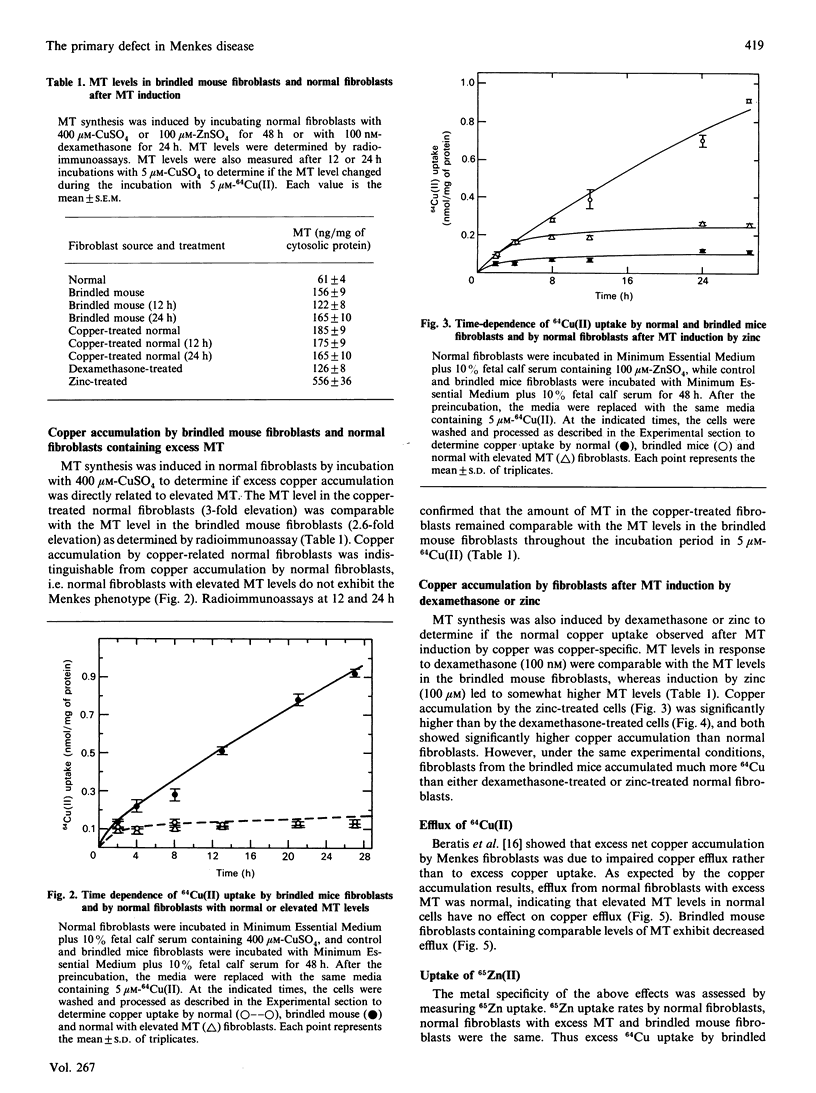
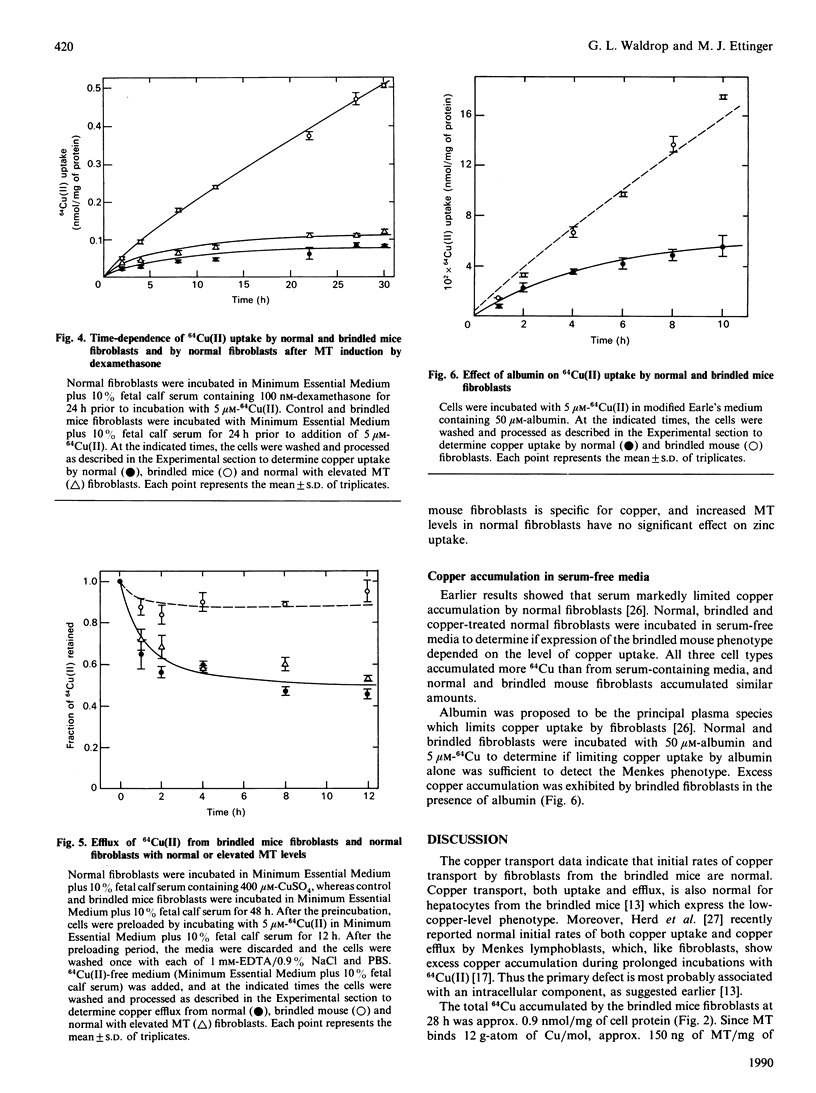
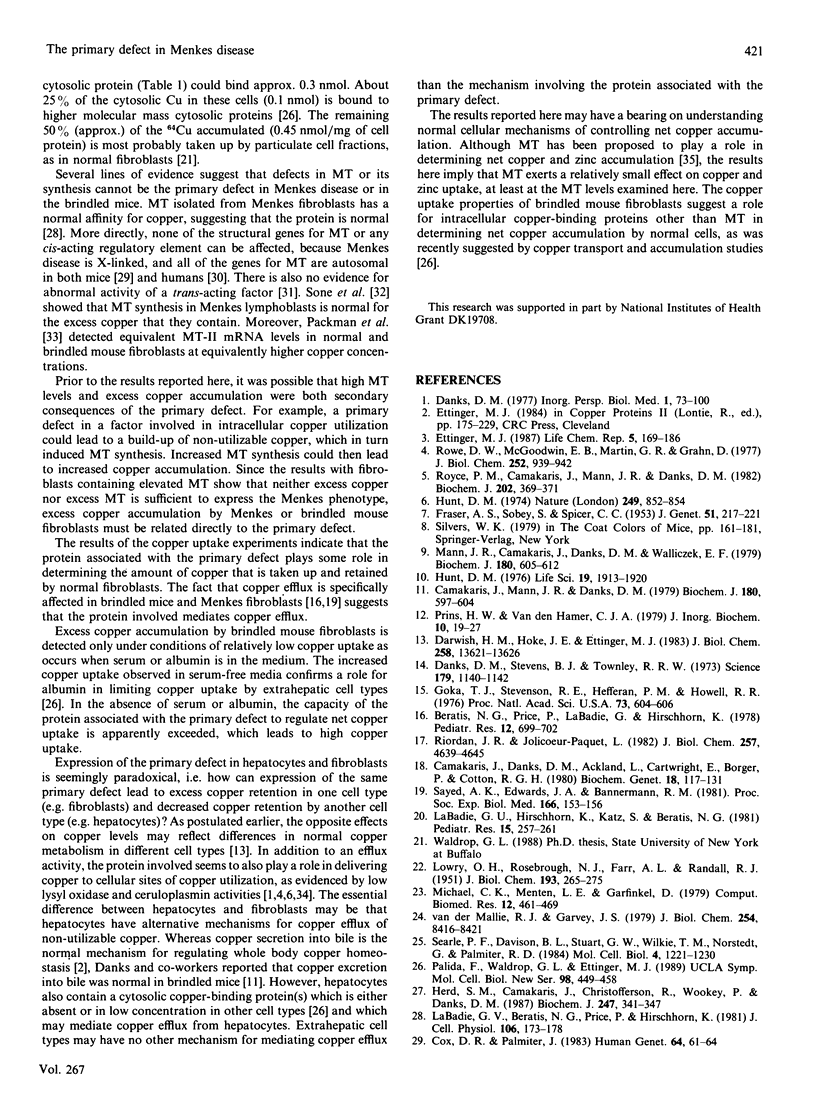
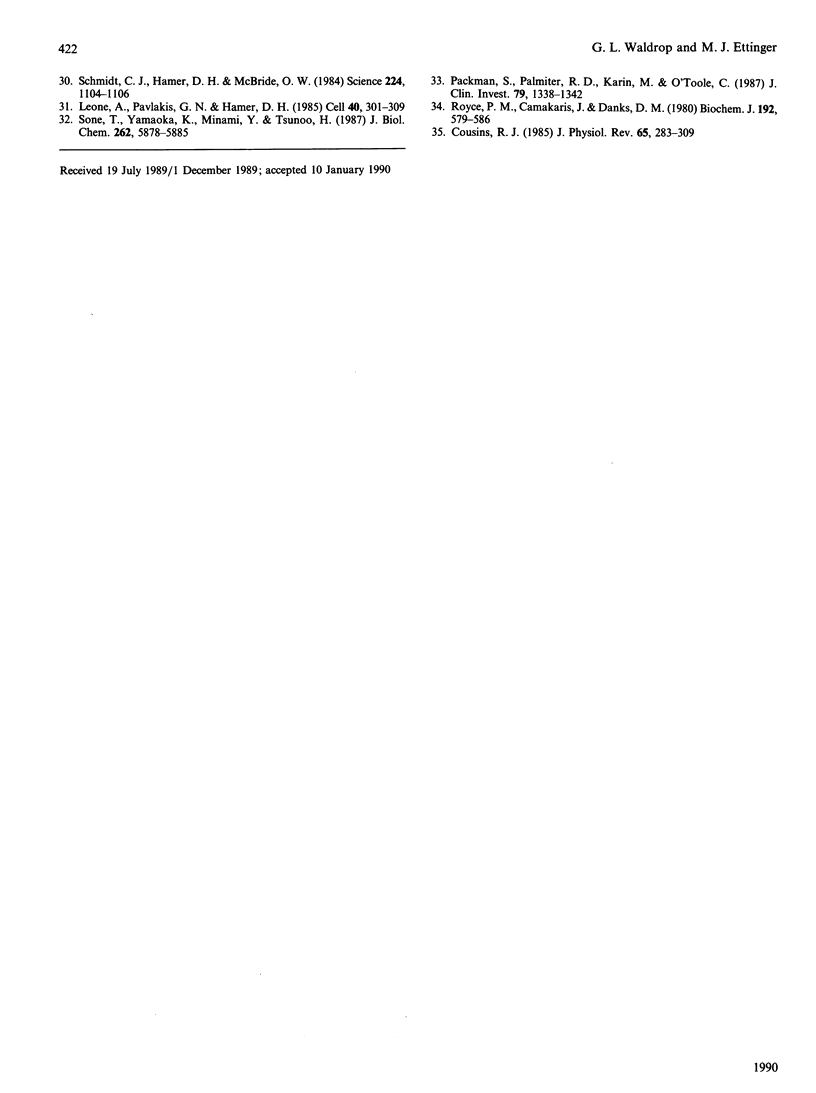
Selected References
These references are in PubMed. This may not be the complete list of references from this article.
- Beratis N. G., Price P., Labadie G., Hirschhorn K. 64Cu metabolism in Menkes and normal cultured skin fibroblasts. Pediatr Res. 1978 Jun;12(6):699–702. doi: 10.1203/00006450-197806000-00004. [DOI] [PubMed] [Google Scholar]
- Camakaris J., Danks D. M., Ackland L., Cartwright E., Borger P., Cotton R. G. Altered copper metabolism in cultured cells from human Menkes' syndrome and mottled mouse mutants. Biochem Genet. 1980 Feb;18(1-2):117–131. doi: 10.1007/BF00504364. [DOI] [PubMed] [Google Scholar]
- Camakaris J., Mann J. R., Danks D. M. Copper metabolism in mottled mouse mutants: copper concentrations in tissues during development. Biochem J. 1979 Jun 15;180(3):597–604. doi: 10.1042/bj1800597. [DOI] [PMC free article] [PubMed] [Google Scholar]
- Cousins R. J. Absorption, transport, and hepatic metabolism of copper and zinc: special reference to metallothionein and ceruloplasmin. Physiol Rev. 1985 Apr;65(2):238–309. doi: 10.1152/physrev.1985.65.2.238. [DOI] [PubMed] [Google Scholar]
- Cox D. R., Palmiter R. D. The metallothionein-I gene maps to mouse chromosome 8: implications for human Menkes' disease. Hum Genet. 1983;64(1):61–64. doi: 10.1007/BF00289481. [DOI] [PubMed] [Google Scholar]
- Danks D. M., Cartwright E., Stevens B. J., Townley R. R. Menkes' kinky hair disease: further definition of the defect in copper transport. Science. 1973 Mar 16;179(4078):1140–1142. doi: 10.1126/science.179.4078.1140. [DOI] [PubMed] [Google Scholar]
- Darwish H. M., Hoke J. E., Ettinger M. J. Kinetics of Cu(II) transport and accumulation by hepatocytes from copper-deficient mice and the brindled mouse model of Menkes disease. J Biol Chem. 1983 Nov 25;258(22):13621–13626. [PubMed] [Google Scholar]
- Goka T. J., Stevenson R. E., Hefferan P. M., Howell R. R. Menkes disease: a biochemical abnormality in cultured human fibroblasts. Proc Natl Acad Sci U S A. 1976 Feb;73(2):604–606. doi: 10.1073/pnas.73.2.604. [DOI] [PMC free article] [PubMed] [Google Scholar]
- Herd S. M., Camakaris J., Christofferson R., Wookey P., Danks D. M. Uptake and efflux of copper-64 in Menkes'-disease and normal continuous lymphoid cell lines. Biochem J. 1987 Oct 15;247(2):341–347. doi: 10.1042/bj2470341. [DOI] [PMC free article] [PubMed] [Google Scholar]
- Hunt D. M. A study of copper treatment and tissue copper levels in the murine congenital copper deficiency, mottled. Life Sci. 1976 Dec 15;19(12):1913–1919. doi: 10.1016/0024-3205(76)90124-7. [DOI] [PubMed] [Google Scholar]
- Hunt D. M. Primary defect in copper transport underlies mottled mutants in the mouse. Nature. 1974 Jun 28;249(460):852–854. doi: 10.1038/249852a0. [DOI] [PubMed] [Google Scholar]
- Kohn M. C., Menten L. E., Garfinkel D. A convenient computer program for fitting enzymatic rate laws to steady-state data. Comput Biomed Res. 1979 Oct;12(5):461–469. doi: 10.1016/0010-4809(79)90032-6. [DOI] [PubMed] [Google Scholar]
- LOWRY O. H., ROSEBROUGH N. J., FARR A. L., RANDALL R. J. Protein measurement with the Folin phenol reagent. J Biol Chem. 1951 Nov;193(1):265–275. [PubMed] [Google Scholar]
- LaBadie G. U., Beratis N. G., Price P. M., Hirschhorn K. Studies of the copper-binding proteins in Menkes and normal cultured skin fibroblast lysates. J Cell Physiol. 1981 Feb;106(2):173–178. doi: 10.1002/jcp.1041060202. [DOI] [PubMed] [Google Scholar]
- Labadie G. U., Hirschhorn K., Katz S., Beratis N. G. Increased copper metallothionein in Menkes cultured skin fibroblasts. Pediatr Res. 1981 Mar;15(3):257–261. doi: 10.1203/00006450-198103000-00012. [DOI] [PubMed] [Google Scholar]
- Leone A., Pavlakis G. N., Hamer D. H. Menkes' disease: abnormal metallothionein gene regulation in response to copper. Cell. 1985 Feb;40(2):301–309. doi: 10.1016/0092-8674(85)90144-8. [DOI] [PubMed] [Google Scholar]
- Mann J. R., Camakaris J., Danks D. M., Walliczek E. G. Copper metabolism in mottled mouse mutants: copper therapy of brindled (Mobr) mice. Biochem J. 1979 Jun 15;180(3):605–612. doi: 10.1042/bj1800605. [DOI] [PMC free article] [PubMed] [Google Scholar]
- Packman S., Palmiter R. D., Karin M., O'Toole C. Metallothionein messenger RNA regulation in the mottled mouse and Menkes kinky hair syndrome. J Clin Invest. 1987 May;79(5):1338–1342. doi: 10.1172/JCI112959. [DOI] [PMC free article] [PubMed] [Google Scholar]
- Prins H. W., Van den Hamer C. J. Primary biochemical defect in copper metabolism in mice with a recessive X-linked mutation analogous to Menkes' disease in man. J Inorg Biochem. 1979 Feb;10(1):19–27. doi: 10.1016/s0162-0134(00)81002-8. [DOI] [PubMed] [Google Scholar]
- Riordan J. R., Jolicoeur-Paquet L. Metallothionein accumulation may account for intracellular copper retention in Menkes' disease. J Biol Chem. 1982 Apr 25;257(8):4639–4645. [PubMed] [Google Scholar]
- Rowe D. W., McGoodwin E. B., Martin G. R., Grahn D. Decreased lysyl oxidase activity in the aneurysm-prone, mottled mouse. J Biol Chem. 1977 Feb 10;252(3):939–942. [PubMed] [Google Scholar]
- Royce P. M., Camakaris J., Danks D. M. Reduced lysyl oxidase activity in skin fibroblasts from patients with Menkes' syndrome. Biochem J. 1980 Nov 15;192(2):579–586. doi: 10.1042/bj1920579. [DOI] [PMC free article] [PubMed] [Google Scholar]
- Royce P. M., Camakaris J., Mann J. R., Danks D. M. Copper metabolism in mottled mouse mutants. The effect of copper therapy on lysyl oxidase activity in brindled (Mobr) mice. Biochem J. 1982 Feb 15;202(2):369–371. doi: 10.1042/bj2020369. [DOI] [PMC free article] [PubMed] [Google Scholar]
- Sayed A. K., Edwards J. A., Bannerman R. M. Copper metabolism of cultured fibroblasts from the brindled mouse (gene symbol Mobr). Proc Soc Exp Biol Med. 1981 Jan;166(1):153–156. doi: 10.3181/00379727-166-41038. [DOI] [PubMed] [Google Scholar]
- Schmidt C. J., Hamer D. H., McBride O. W. Chromosomal location of human metallothionein genes: implications for Menkes' disease. Science. 1984 Jun 8;224(4653):1104–1106. doi: 10.1126/science.6719135. [DOI] [PubMed] [Google Scholar]
- Searle P. F., Davison B. L., Stuart G. W., Wilkie T. M., Norstedt G., Palmiter R. D. Regulation, linkage, and sequence of mouse metallothionein I and II genes. Mol Cell Biol. 1984 Jul;4(7):1221–1230. doi: 10.1128/mcb.4.7.1221. [DOI] [PMC free article] [PubMed] [Google Scholar]
- Sone T., Yamaoka K., Minami Y., Tsunoo H. Induction of metallothionein synthesis in Menkes' and normal lymphoblastoid cells is controlled by the level of intracellular copper. J Biol Chem. 1987 Apr 25;262(12):5878–5885. [PubMed] [Google Scholar]
- Vander Mallie R. J., Garvey J. S. Radioimmunoassay of metallothioneins. J Biol Chem. 1979 Sep 10;254(17):8416–8421. [PubMed] [Google Scholar]


